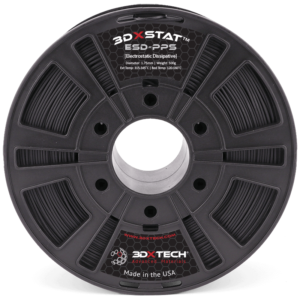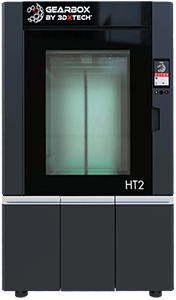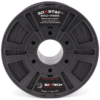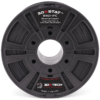3DXSTAT ESD-PPS [Polyphenylene Sulfide]
$65.00
3DXSTAT™ ESD-Safe PPS [Polyphenylene Sulfide] is a high-performance polymer that exhibits exceptional chemical resistance along with ESD surface resistance. Widely known as one of the most chemically resistant thermoplastic materials available, PPS is insoluble in any known solvent under 200°C.
3DXSTAT™ ESD PPS 3D Filament
ESD PPS (Polyphenylene Sulfide) is an electro-static discharge (ESD) safe formulation of PPS, a high-performance polymer which exhibits exceptional chemical resistance along with high thermal and mechanical properties. Widely known as one of the most chemically resistant thermoplastic materials available.
ESD PPS is completely insoluble in any known solvent under 200°C.
ESD PPS is used in some of the most demanding applications in Auto, Chemical Processing, Oil & Gas, and Electronics. It is inherently flame retardant and self extinguishing, making it an ideal material for electrical and electronics applications.
Gearbox HT2™ 3D Printer: Print industrial-grade parts using our ESD PPS and more with the new Gearbox™ HT2 High-Temp 3D Printer.
Print Recommendations
![3DXSTAT ESD-PPS [Polyphenylene Sulfide] Ext Temp 1 Ext Temp 1](https://www.3dxtech.com/wp-content/uploads/2021/01/Ext-Temp-1-1024x1024.jpg)
Extruder Temp
315-345°C
![3DXSTAT ESD-PPS [Polyphenylene Sulfide] Bed Temp Bed Temp](https://www.3dxtech.com/wp-content/uploads/2021/01/Bed-Temp-1024x1024.jpg)
Bed Temp
120-160°C
![3DXSTAT ESD-PPS [Polyphenylene Sulfide] Chamber Temp Chamber Temp](https://www.3dxtech.com/wp-content/uploads/2021/01/Chamber-Temp-1024x1024.jpg)
Heated Chamber
Recommended
60-90°C if possible
![3DXSTAT ESD-PPS [Polyphenylene Sulfide] Nozzle Settings Nozzle Settings](https://www.3dxtech.com/wp-content/uploads/2021/01/Nozzle-Settings-1024x1024.jpg)
Nozzle Specs
No special concerns
![3DXSTAT ESD-PPS [Polyphenylene Sulfide] Bed Adhesion Bed Adhesion](https://www.3dxtech.com/wp-content/uploads/2021/01/Bed-Adhesion-1024x1024.jpg)
Bed Adhesion
Nano Polymer Adhesive
![3DXSTAT ESD-PPS [Polyphenylene Sulfide] Layer Height Layer Height](https://www.3dxtech.com/wp-content/uploads/2021/01/Layer-Height-1024x1024.jpg)
Layer Height
No special concerns
![3DXSTAT ESD-PPS [Polyphenylene Sulfide] Drying Filamen Drying Filamen](https://www.3dxtech.com/wp-content/uploads/2021/01/Drying-Filamen-1024x1024.jpg)
Drying Specs
110°C for 4 hours
![3DXSTAT ESD-PPS [Polyphenylene Sulfide] Break Away Support Break Away Support](https://www.3dxtech.com/wp-content/uploads/2021/01/Break-Away-Support-1024x1024.jpg)
Supports
Break-Away Support
Benefits of PPS Include:
- Melting temperatures (Tm) of 285°C
- Glass Transition temperature (Tg) of 85°C
- Excellent chemical resistance, insoluble in ANY known solvent under 200°C
- Stable dielectric constant and dissipation factor over a wide range of temps and frequencies.
- Inherently flame resistant and self-extinguishing
- Long-term hydrolytic stability for very low moisture absorption
- Exceptional strength and modulus even at elevated temperatures
Benefits of 3DXSTAT™ Include:
- Consistent surface resistivity
- Improved retention of impact & elongation
- Low particulate contamination
- Minimal contribution to outgassing and ionic contamination
Typical ESD PPS Applications Include:
- Semi-con: HDD Components, Wafer Handling, Jigs, Casings, & Connectors
- Industrial: Conveying, Metering, and Sensing Applications
Target Conductivity for 3DXSTAT™ ESD PPS:
- 10^7 to 10^9 ohm surface resistivity on 3DP sample using concentric ring test method.
- Note: Internal studies have indicated that increased extruder temperatures can achieve higher levels of conductivity. Likewise, lower extruder temperatures have resulted in lower levels of conductivity. Each printer is set-up differently as well as varied part geometry. Therefore, expect some trial time to understand how this filament works in your specific printer / application. However, please do not exceed 270°C to reduce the risk of polymer degradation.
Surface Conductivity as a Function of Extruder Temperature:
The surface resistance of the printed ESD PPS part will vary depending on the printer’s extruder temperature. For example, if your testing indicates the part is too insulative, then increasing the extruder temperature will result in improved conductivity. Therefore, the surface resistance can be ‘dialed-in’ by adjusting the extruder temperature up or down depending on the reading you receive on your part.
![3DXSTAT ESD-PPS [Polyphenylene Sulfide] esd pps resistance esd pps resistance](https://www.3dxtech.com/wp-content/uploads/2020/12/esd-pps-resistance.png)
Filament Specifications:
1.75mm and 2.85mm +/- 0.05mm in diameter
Recommended Print Settings:
- Extruder: 315-345°C
- Bed Temp: 120-160°C
- Bed Prep: Nano Polymer Adhesive or 3DXTECH Polyimide Tape gives us the best results
- Heated Chamber: Recommended, held up to 60-90°C if at all possible
- Supports: ThermaX™ break-away HTS High Temp Support material is specially designed to work with complex, high-temp filaments like this
- Drying Instructions: 110°C for 4 hours
Annealing (Post-Crystalizing) 3D Printed PPS Parts:
Parts printed with PPS must be annealed after printing to ramp-up the crystallinity in the resin. This will maximize mechanical, thermal, and chemical resistance properties. Full annealing generally requires 2-4 hours of heating at 130°C. The following process for annealing your ThermaX™ PPS parts will help assure ideal performance.
- Place printed parts in cool, room-temp oven. Supports may be left on the part if there is a risk of part warping without them.
- Set temp to 80°C and allow to stabilize for 1 hour.
- Raise oven temperature to 130°C and allow to stabilize 2-3 hours, longer depending upon the size/thickness of the part.
- Turn off oven heat and allow the printed part to cool to room temperature.
Questions?
Send us a message and we'll reach out as soon as we can!

![3DXSTAT ESD-PPS [Polyphenylene Sulfide] 439 ESD PPS 175mm Black 500g 3D Printer Filament ESD PPS 1.75mm Black 500g 3D Printer Filament](https://www.3dxtech.com/wp-content/uploads/2021/01/439-ESD-PPS-175mm-Black-500g-3D-Printer-Filament.png)



